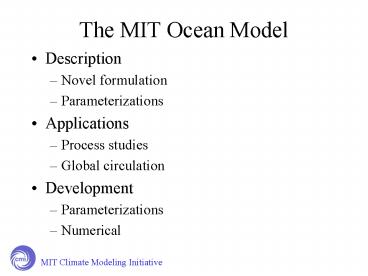The MIT Ocean Model - PowerPoint PPT Presentation
1 / 18
Title:
The MIT Ocean Model
Description:
Equal t in external mode & momentum eqns. Allows 'natural' fresh-water flux ... Gent-McWilliams (Geostrophic eddies) KPP (BL scheme) [Convective adjustment] 4 ... – PowerPoint PPT presentation
Number of Views:23
Avg rating:3.0/5.0
Title: The MIT Ocean Model
1
The MIT Ocean Model
- Description
- Novel formulation
- Parameterizations
- Applications
- Process studies
- Global circulation
- Development
- Parameterizations
- Numerical
2
Description I
- Grid-point model
- Arakawa C grid
- Z coordinate
- Hydrostatic ? Non-hydrostatic
- Process studies
- Global circulation
- Highly portable
- Very efficient
3
Description II
- Implicit free surface
- Equal ?t in external mode momentum eqns
- Allows natural fresh-water flux
- Non-linear equation of state
- Parameterizations
- Gent-McWilliams (Geostrophic eddies)
- KPP (BL scheme)
- Convective adjustment
4
Applications
- Data assimilation (MIT, JPL, Scripps)
- constrained estimates of circulation
- bio-geochemical cycles (MIT, Goddard)
- Process studies
- lab. Experiments, Labrador Sea, Internal waves
- Climate (MIT, JPL, ETH)
- ocean only, coupled
- Coastal (U. Conn.)
5
Key Numerical Innovations
- Finite Volume
- allows shaved cell representation of topography
- Hydrostatic ? Non-hydrostatic
- applicable to a wide range of dynamical scales
- Coriolis term (CD scheme)
- allows C grid solution at low resolution
6
Finite Volume Shaved cells
7
Hydraulic Control in Overflows
- E.g. Denmark Straight overflow
Legg WHOI
8
Breaking Internal Waves
Legg Wunsch WHOI/MIT
9
CD scheme
10
General CirculationBasic Setup
- 2.8 x 2.8 x 15 levels (128x64 points)
- Forced with observed surface fluxes
- stress, heat, fresh-water
- restoring to Levitus SST (36 W m-2)
- monthly data
- Realistic topography
- Gent-McWilliams eddy parameterization
11
ETOPO51/12º x 1/12º
Model2.8º x 2.8º
12
Heat Transport (PW)
Fresh Water Transport (Sv)
13
Global Overturning ?(y,z)
CI 5 Sv
14
Atlantic ?(y,z)
CI 5 Sv
Indo-Pacific ?(y,z)
15
Drift from Levitus
16
Ongoing Developments I
- Formulation
- Curvilinear coordinates (horizontal)
- Move pole over Greenland ? avoid converging
meridians in Arctic Ocean - Place more resolution in boundary currents
- Cubed sphere ? more uniform resolution
- Hybrid vertical coordinate
- More adiabatic
- BBL parameterization
- Semi-implicit time-stepping
17
Ongoing Developments II
- Parameterizations
- Eddy parameterizations
- Visbeck et al.
- T.E.M. ? Potential Vorticity flux
- Bottom Boundary Layer
- Killworth
- Ganadesikan
- Internal Wave Breaking
- Polzin
18
Related Ongoing Work
- Passive Tracer experiments (Follows)
- Carbon cycle modeling
- Geo-thermal heating (Scott, Marotzke)
- Response to fresh-water forcing (Stone)
- Coupling
- to MIT Intermediate Atmosphere (Marshall)
- to ECHAM (Sheinin)































